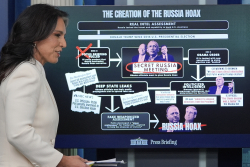Russia’s new “autonomous” tank reuses outdated T-72/T-90 hulls and lacks real autonomy, revealing more about cost-cutting and propaganda than genuine battlefield innovation or AI integration.
The Russian military has unveiled a new “autonomous ground combat system,” and announced it is now undergoing field trials. The “Shturm” was developed under orders from the Ministry of Defense at the Uralvagonzavod tank plant, and is meant to operate with limited remote control in urban environments.
Video of the “new” platform was first shared by Russian military blogger (mil-blogger) and open source analyst Andrei_bt on the Telegram social messaging app.
However, the mil-blogger was dismissive of the Shturm’s capabilities, writing, “This is not a new thing at all, they have been sawing it off since the Armata for a decade now. The idea itself is also not new; see the detailed description of this project and why it is a typical UVZ money-making scheme.”
What Is the “Shturm” Tank
The “new” AI-powered platform is built on a heavily modified T-72 or T-90 main battle tank (MBT) chassis. It is armed with a 125mm D-414 main gun that was shortened and modified for urban operations. The front of the vehicle is outfitted with a bulldozer blade to help it move obstacles rather than merely rolling over them.
The Shtrum has been in development for several years, being first announced in 2018 as a modular platform designed for urban warfare. Yet, progress has been slow going. Unlike the next-generation T-14 Armata MBT, which was intended to be a clean break from legacy Soviet-era platforms, this robotic tank’s foundation is very much rooted in the past. Cost may be a factor.
“Using older T-72A hulls suggests the system was developed with cost efficiency and legacy equipment in mind,” Interesting Engineering explained.
The Kremlin has burned through its stockpiles of Cold War-era tanks and other equipment to replenish the losses it has suffered in its ongoing war in Ukraine, but it still may have adequate numbers of T-72s that it can employ to produce a batch of Shturm robotic tanks. The vehicle is far less modular than initially planned, but that is hardly a surprise.
Variants were to include a 50-ton assault vehicle, armed with a 125mm or even a 152mm main gun; a version equipped with a RPO-2 “Shemel” thermobaric rocket launcher and PKTM machine gun to support a close-quarters assault; and another armed with the RPO-2 and twin 30mm 2A42 automatic cannons and PKTM machine gun, which could offer infantry suppression capabilities.
A fourth version, developed for wide-area assaults, was reported to be equipped with 16 unguided 220mm thermobaric rockets, the same that are used on Russia’s TOS-1A multiple rocket launch platform.
For now, progress is focused on the basic model with an adapted 125mm D-414 main gun that allows for 360-degree turret rotation, even in narrow urban environments.
The “Shturm” Is Not Fully Autonomous
The other significant change is that the assault vehicle was to be remotely operated from a command-and-control car, and it would also have some autonomous capabilities.
The recent video showed a crew on board the vehicle in its tests, suggesting that neither the remote controls nor its autonomous capabilities are quite ready yet. That puts into question the very purpose the Shturm is meant to serve.
The modular platform was designed to conduct operations against fortified positions and to launch attacks in urban settings, which could suggest that Russia had designs on an adversary’s cities.
A significant portion of the fighting in the Russo-Ukrainian conflict has taken place in urban areas, and the war has made it clear that cities remain of strategic importance. Yet, they are often the site of heavy casualties.
About the Author: Peter Suciu
Peter Suciu has contributed over 3,200 published pieces to more than four dozen magazines and websites over a thirty-year career in journalism. He regularly writes about military hardware, firearms history, cybersecurity, politics, and international affairs. Peter is also a Contributing Writer for Forbes and Clearance Jobs. He is based in Michigan. You can follow him on Twitter: @PeterSuciu. You can email the author: [email protected].
Image Credit: Russian MoD.

















